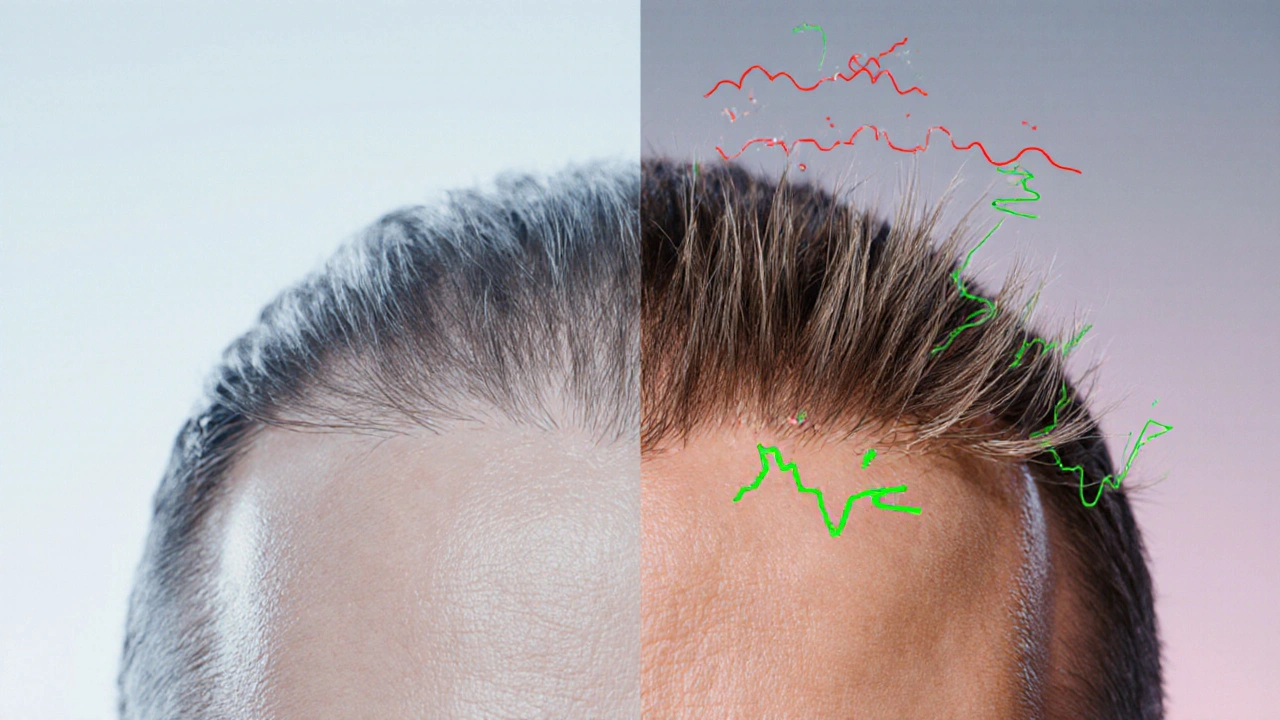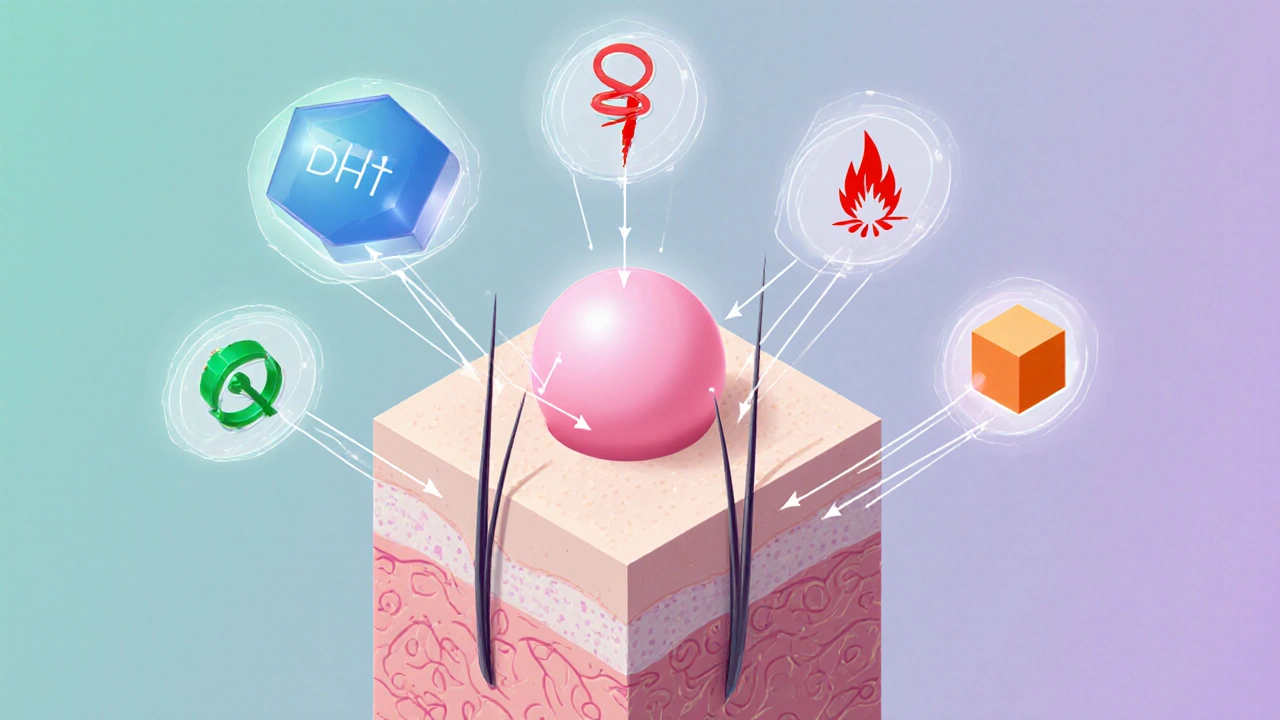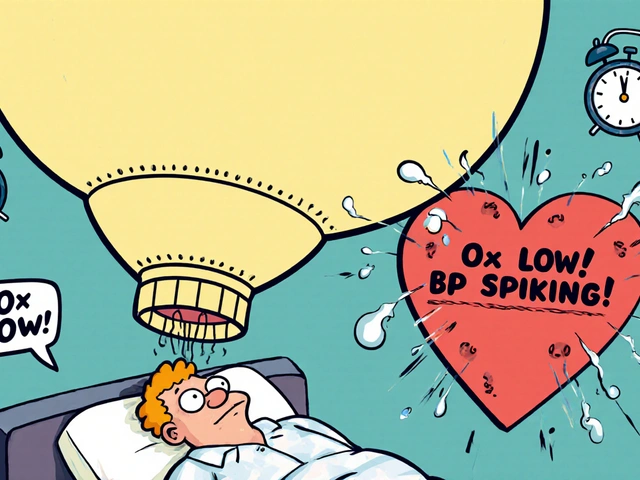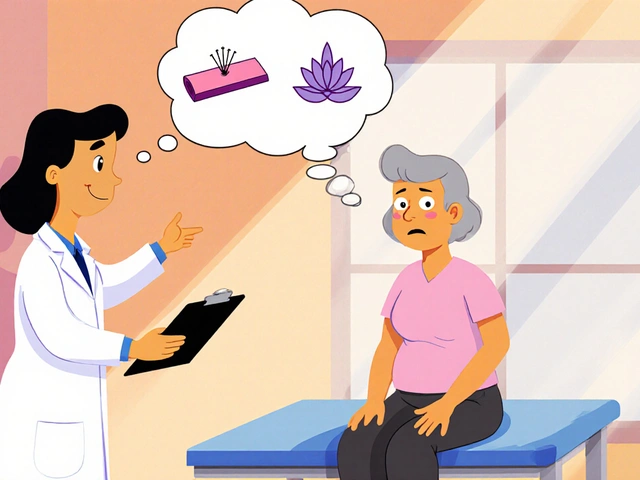Hormone & Alopecia Impact Checker
Select a hormone to see its impact on hair follicles and typical patterns of hair loss:
DHT
Dihydrotestosterone
Estrogen
Female Hormone
Thyroid
T3/T4
Cortisol
Stress Hormone
Insulin
Blood Sugar
Select a hormone and click "Check Hormone Impact" to see its effect on hair follicles and typical alopecia patterns.
Quick Takeaways
- Hormones control the growth‑rest cycle of each hair follicle.
- Elevated DHT, low estrogen, thyroid dysfunction, high cortisol or insulin spikes can all start or worsen alopecia.
- Male‑pattern and female‑pattern loss (androgenic alopecia) is the most common hormone‑driven form.
- Stress‑related spikes in cortisol, pregnancy‑related estrogen shifts, and thyroid disease each have distinct patterns of hair shedding.
- Medical tests, lifestyle tweaks, and targeted therapies can restore hormonal balance and stop further loss.
When it comes to hair loss, the culprit often isn’t a mystery-it’s hormones and alopecia working together. Understanding which hormones are at play, how they affect the hair follicle, and what you can do about it turns a scary situation into a manageable one.
What Are Hormones?
Hormones are chemical messengers released by endocrine glands into the bloodstream, where they travel to target organs and regulate physiological processes. They govern metabolism, growth, mood, and, crucially for our topic, the hair growth cycle. Because they circulate system‑wide, a shift in one hormone can ripple through many tissues, including the skin and hair follicles.
Defining Alopecia
Alopecia is the medical term for hair loss, encompassing a spectrum from temporary shedding to permanent baldness. The condition can be localized (patchy) or diffuse (whole‑scalp) and is classified by cause-genetic, autoimmune, traumatic, or hormonal.
How Hormones Talk to the Hair Follicle
Each hair follicle cycles through three phases: anagen (growth), catagen (transition), and telogen (rest). Hormones act like traffic lights, signaling follicles when to stay in growth mode or when to pause. When the signaling gets off‑balance, more follicles linger in telogen, leading to visible thinning.
The follicle itself is a mini‑organ composed of keratin‑producing cells, a dermal papilla rich in blood vessels, and a surrounding sebaceous gland that lubricates the shaft. Hormonal receptors sit on the dermal papilla and sebaceous cells, allowing hormones to directly affect follicle size, sebum output, and the timing of the growth cycle.

Key Hormones That Drive Alopecia
- Dihydrotestosterone (DHT): A potent derivative of testosterone that binds strongly to androgen receptors on the dermal papilla. High scalp DHT shrinks follicles, shortens anagen, and eventually converts thick hairs into fine vellus hairs. This is the engine behind androgenic alopecia.
- Estrogen: Often protective for hair. It prolongs the anagen phase and boosts sebum production, keeping follicles hydrated. Low estrogen-common after menopause or during postpartum-can tip the balance toward shedding.
- Thyroid hormone (T3/T4): Regulates metabolic rate and keratinocyte turnover. Both hyper‑ and hypothyroidism can cause diffuse telogen effluvium because the follicle receives erratic metabolic signals.
- Cortisol: The stress hormone spikes during chronic anxiety, sleep deprivation, or illness. Elevated cortisol shortens anagen, pushes follicles into telogen, and can trigger sudden shedding known as telogen effluvium.
- Insulin: High insulin levels (as seen in insulin resistance or PCOS) increase androgen production in the ovaries and adrenal glands, amplifying DHT’s impact on the scalp.
Hormonal Imbalance Scenarios That Lead to Specific Alopecia Types
Androgenic Alopecia (Male‑Pattern & Female‑Pattern)-The classic “receding hairline” or “diffuse thinning” picture. Elevated scalp DHT is the main driver, often compounded by genetic sensitivity of androgen receptors. Women with PCOS often experience this pattern because excess ovarian androgens raise DHT levels.
Telogen Effluvium-A sudden, diffuse shedding lasting weeks to months. Triggers include severe stress (cortisol surge), rapid weight loss, or abrupt thyroid changes. The hair follicle abruptly exits anagen, sending many hairs into telogen simultaneously.
Female‑Pattern Alopecia Linked to Menopause-Estrogen drops while androgens stay steady, effectively increasing the androgen‑to‑estrogen ratio. The result is a shift toward miniaturization of follicles, especially in the crown area.
Thyroid‑Related Alopecia-Both hypothyroidism (low T3/T4) and hyperthyroidism (excess T3/T4) disrupt the hair cycle, causing either dry, brittle hair that falls out (hypothyroid) or fine, easily lost hair (hyperthyroid). The pattern often mimics diffuse or patchy loss.
Managing Hormone‑Related Alopecia
When hormones are the culprits, treating the underlying endocrine issue usually restores normal hair growth. Below are proven steps.
- Get Tested. Baseline labs should include total and free testosterone, DHT, estradiol, TSH, free T4, cortisol (morning and evening), fasting insulin, and lipids. A dermatologist or endocrinologist can interpret the results.
- Address Lifestyle Triggers. Regular sleep (7‑9h), stress‑reduction practices (mindfulness, exercise), and a low‑glycemic diet keep cortisol and insulin spikes in check. Adequate protein (1.2‑1.5g/kg) supplies the building blocks for keratin.
- Consider Medical Therapies.
- 5‑alpha‑reductase inhibitors (finasteride, dutasteride) lower DHT production. Studies show a 30‑45% increase in hair count after 12months.
- Topical minoxidil prolongs anagen and improves follicle size, useful for both androgenic and telogen types.
- Anti‑thyroid meds (levothyroxine for hypothyroidism) or antithyroid drugs (methimazole for hyperthyroidism) normalize thyroid hormone levels.
- Spironolactone blocks androgen receptors and reduces sebum, especially effective in women with PCOS.
- Supplement Wisely. Biotin, zinc, and vitamin D deficiencies exacerbate shedding. A daily 1000IU vitaminD supplement helps when serum levels are below 30ng/mL.
- Monitor Progress. Take monthly photos and track hair density with a handheld dermatoscope or a simple scalp ruler. Visible improvement usually appears after 3‑6months of consistent therapy.
Comparison of Hormones and Their Typical Alopecia Impact
| Hormone | Primary Effect on Hair | Typical Alopecia Pattern | Common Intervention |
|---|---|---|---|
| DHT | Follicle miniaturization, shortened anagen | Androgenic (male‑pattern/female‑pattern) | 5‑alpha‑reductase inhibitors, minoxidil |
| Estrogen | Prolongs anagen, boosts sebum | Post‑menopause thinning | Hormone replacement, phyto‑estrogen diet |
| Thyroid hormone (T3/T4) | Alters metabolic signaling, irregular cycle | Diffuse telogen effluvium | Thyroid medication, dietary iodine |
| Cortisol | Shortens anagen, increases shedding | Stress‑induced telogen effluvium | Stress management, sleep hygiene |
| Insulin | Stimulates ovarian androgen production | PCOS‑related androgenic loss | Low‑glycemic diet, metformin |
Practical Checklist for Hormone‑Related Hair Loss
- Schedule a full endocrine panel with your doctor.
- Track daily stress levels and aim for < 10% high‑stress days.
- Adopt a Mediterranean‑style diet: lean protein, omega‑3 fats, plenty of leafy greens.
- Start topical minoxidil (2% for women, 5% for men) if early thinning appears.
- Re‑evaluate hair density every 12weeks; adjust treatment if no improvement.

Frequently Asked Questions
Which hormone is the biggest driver of male‑pattern baldness?
Dihydrotestosterone (DHT) is the primary culprit. It binds tightly to androgen receptors in scalp follicles, forcing them to shrink and produce thinner hairs.
Can high cortisol cause permanent hair loss?
Normally cortisol‑induced shedding is reversible (telogen effluvium). If stress persists for years, the repeated cycles can weaken follicles, making recovery slower, but the loss itself isn’t typically permanent.
Do thyroid‑medicated patients ever need hair‑specific treatment?
Yes. Even with normalized thyroid labs, some people benefit from minoxidil or low‑dose finasteride to kick‑start follicle regrowth while the thyroid stabilizes.
Is there a quick test to measure scalp DHT?
Direct scalp DHT testing is rare; most clinicians infer levels from serum testosterone and a 5‑alpha‑reductase inhibition trial. A noticeable response to finasteride often confirms DHT involvement.
Can diet alone reverse hormonal alopecia?
Diet can curb insulin spikes and improve thyroid health, which helps prevent further loss. However, established follicle miniaturization usually needs medical therapy in addition to dietary changes.




